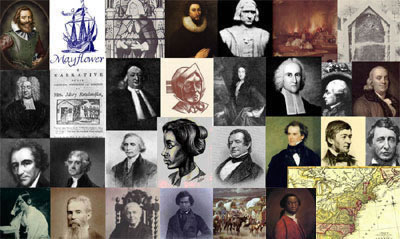The Romantic movement, which originated in Germany but quickly spread to England , France , and beyond, reached America America as in Europe , fresh new vision electrified artistic and intellectual circles. Yet there was an important difference: Romanticism in America
Romantic ideas centered around art as inspiration, the spiritual and aesthetic dimension of nature, and metaphors of organic growth. Art, rather than science, Romantics argued, could best express universal truth.
The development of the self became a major theme; self-awareness a primary method. If, according to Romantic theory, self and nature were one, self-awareness was not a selfish dead end but a mode of knowledge opening up the universe. If one's self were one with all humanity, then the individual had amoral duty to reform social inequalities and relieve human suffering. The idea of "self" -- which suggested selfishness to earlier generations -- was redefined. New compound words with positive meanings emerged: "self-realization," "self-expression," "self-reliance."
Walt Whitman, Nathaniel Hawthorne, Herman Melville, Edgar Allan Poe, Emily Dickinson, and the Transcendentalists represent the first great literary generation produced in the Instead of carefully defining realistic characters through a wealth of detail, as most English or continental novelists did,
The American novelist had to depend on his or her own devices.
The Transcendentalists
The Transcendentalist movement was based on a fundamental belief in the unity of the world and God. The soul of each individual was thought to be identical with the world -- a microcosm of the world itself.Transcendentalism was intimately connected with Concord , Massachusetts Concord
The Transcendentalists published a quarterly magazine, The Dial, which lasted four years and was first edited by Margaret Fuller and later by Emerson. Reform efforts engaged them as well as literature. A number of Transcendentalists were abolitionists, and some were involved in experimental utopian communities such as nearby Brook Farm (described in Unlike many European groups, the Transcendentalists never issued a manifesto. They insisted on individual differences -- on the unique viewpoint of the individual. American Transcendental Romantics pushed radical individualism to the extreme. American writers often saw themselves as lonely explorers outside society and convention. The American hero -- like Herman Melville's Captain Ahab, or Mark Twain's Huck Finn, or Edgar Allan Poe's Arthur Gordon Pym -- typically faced risk, or even certain destruction, in the pursuit of metaphysical self-discovery. For the Romantic American writer, nothing was a given. Literary and social conventions, far from being helpful, were dangerous. There was tremendous pressure to discover an authentic literary form, content, and voice -- all at the same time. It is clear from the many masterpieces produced in the three decades before the U.S. Civil War (1861-65) that American writers rose to the challenge.


No hay comentarios:
Publicar un comentario